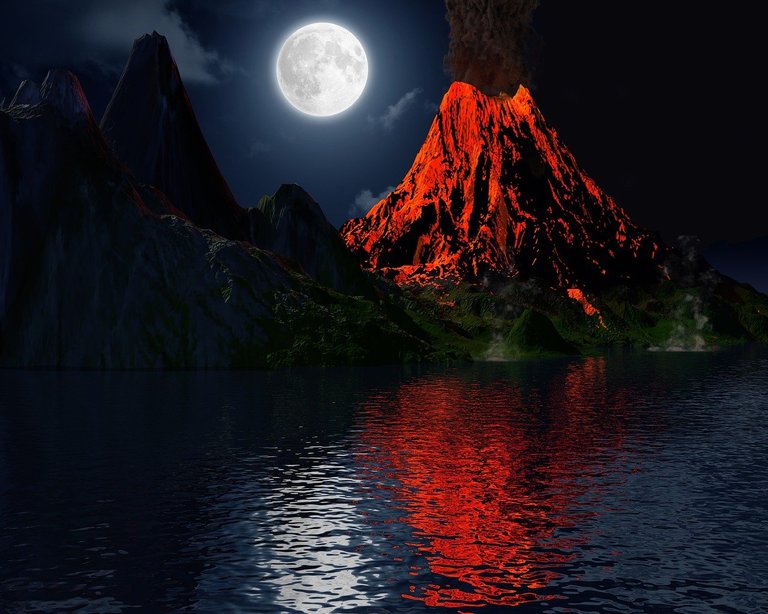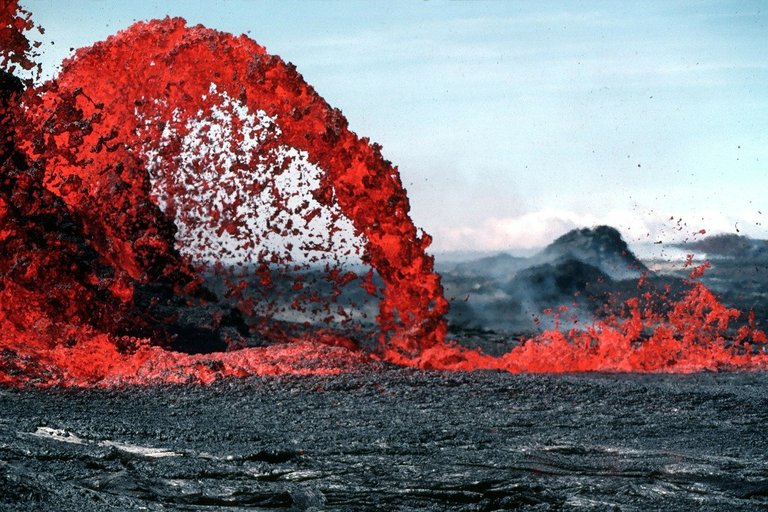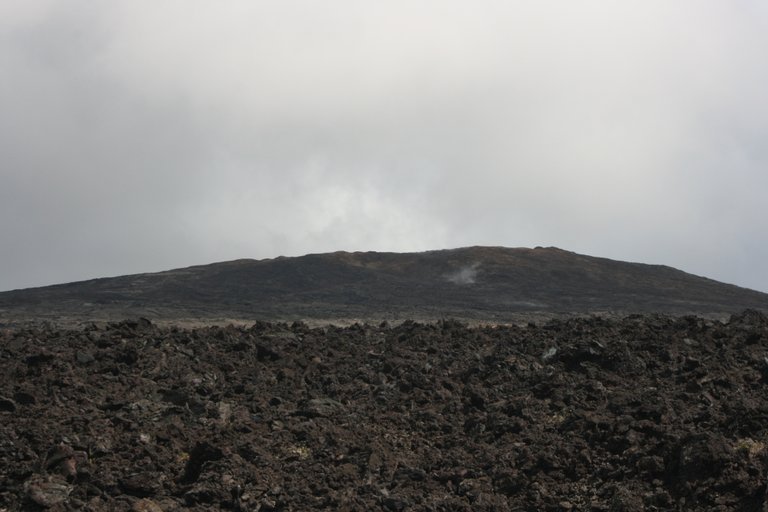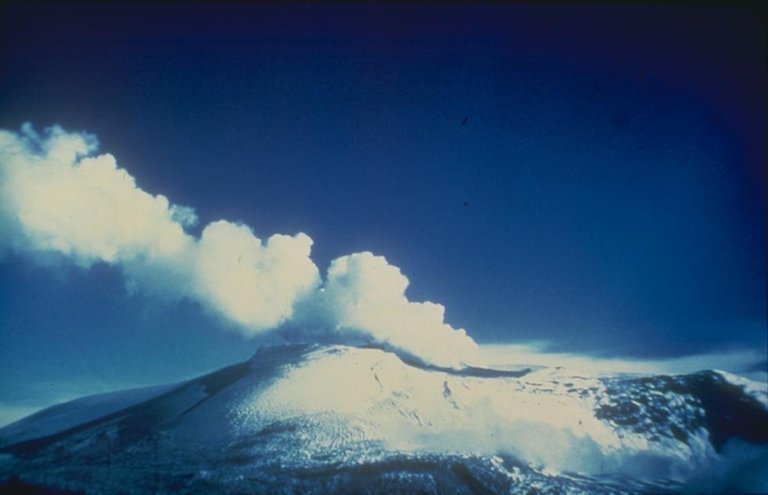When I was a kid, I saw a movie, though I can't remember it's name, but I think that movie is my first encounter with volcanic eruption. Right now everytime I think or read about volcanic eruption I can't help but picture that little boy I saw on the T.V running away from a "flowing fire". Yes, "flowing fire", that was what I thought it was when I was a kid.
Nature can be mean sometimes. Whenever I think about natural disasters, like the volcanic eruption, which seems as if nature spits out fire with the intention of consuming us, I can't help but wonder if it is a means nature have decided to punish man for his "trespasses". Well, no one knows, we really can't ask nature, can we?

pixabay.com: Volcanic Eruption
In this article, I will be telling us what a volcano is, how volcanic eruption occur, different types of eruptions and volcanoes and how you can survive a volcanic eruption. Ride with me, allow me to take you in this journey of knowledge. It's gonna be fun. I assure you.
VOLCANOES
Volcanoes are openings on the surface of the earth in which a very hot mixture of gases, ash, lava and other substances that are burning under the earth surface e.t.c escape out of the ground and releases itself on the surface of the earth.
Volcanoes are very easy to noticed, they look like a mountain, but unlike a mountain that that is made of a giant heap of sand and rocks, volcanoes are more like a heap formed by the mixture if ashes, dust, lava and other stuffs, that has an opening, most times, in the center. It is worth noting though, that volcanoes can lead to the formation of mountains, plateaus, rocks e.t.c. Since, they suddenly erupt, it is logical to think that the spot at which the eruption occur is the weakest zone or point in the earth's crust.
SUPERVOLCANO
I feel the need to define what a supervolcano is. A Supervolcano is a more severe form of volcano, with the largest eruption magnitude, of 8. It normally occurs due to a very large pressure build up and a large amount of molten magma under the earth's surface. When it erupts, it can deposit lava to an area of more than 240 cubic miles.
TYPES OF VOLCANOES
There are majorly four types of volcanoes, they are: shield volcanoes, Lava domes, cinder cones, and composite volcanoes. Let me explain each of them.
Shield Volcanoes:-
This type of volcanoes, are found mostly on tensional or constructive boundaries.
When a eruption occurs through multiple vents, the fluid lava spreads itself over a very vast area of the surrounding, but due to the viscous nature of the lava, it doesn't pile up in one place like a cone, but instead, it forms a little elevation that is shaped like the shield of a warrior. An example of this kind of volcano, is Mount Kilauea and Mount Maunaloa found in Hawaii.
Lava Domes
This kind of volcanoes are normally formed by lavas that are not too viscous. Viscosity reduces cooling rate. Since this kind of lava is not too viscous, it doesn't spread so far and it cools faster. Because it didn't spread far, it forms a pile round the vent where the eruption occurred. But, as the vent increases, the size of the dome increases. Lava domes are known for having steep walls, and the may contain rocks like the dacites, the andesites or rhyolites.
Cinder Cones:-
The most common of all volcanoes, the cinder cones have a crater in the middle at the point where the eruption occurred. It is normally formed when the lava gets ejected into the air and it falls as ash round the vent, leading to the formation of a cone. The height of the cone is totally dependent on how long the eruption lasted and the amount of lava that came out from the earth's surface, thus, if the lava is much, and the eruption occurred for quite a long period of time, the cone formed will be very high. These cones can be as high as 1200ft. The Paricutin Volcano in Mexico is a perfect example of this type of volcano.
Composite Volcanoes:-
These type of volcanoes are usually very tall, about 8000ft in height. They are called composite volcanoes because they are formed by varying layers of ash, rocks, dust and lava. They are very massive. Examples of this type of volcanoes is the Mount Fuji in Japan and Mount Cotopaxi in Ecuador. Another name for composite volcanoes is Stratovolcanoes.
REASONS WHY VOLCANIC ERUPTIONS OCCUR
To better understand why volcanic eruption occur, we need to know how the earth is arranged.
The earth is in three layers.
The one at the outermost part or crust is the part we stand on, i.e the one we build our house on. This layer of the earth we live in goes about 1800 miles into the earth before we get the next layer of the earth which is the mantle. After the mantle we then have the core. This core that is in the center of the earth is most times divided into the inner and the outer core.
This mantle which is the second layer of the earth is made up of gasses and molten material (i.e, the materials in the mantle are rocks that are in the melted formed). The reason why these materials are in the melted form is due to the excessive heat as one goes deep into the earth. This rocks that are in its melted (molten) state in the mantle are what we know as magma.
Rocks found under the surface of the earth contain minerals like aluminium, magnesium, oxygen, iron, silicon and magnesium. This magma, which is liquid contain all these minerals in it.
Remember that these magma contain gases, thus there is a pressure build up in the mantle. When this pressure becomes so much, that the earth can't hold it anymore, this magma seeks for a place to escape. And once it finds a weak spot, eruption occurs, and the magma gets released on to the surface of the earth.
When this magma gets to the surface of the earth, it is called lava, and the average temperature of this lava is about 2,200°F. Lava's are thick, and normally reddish in colour when they erupt, but as it cools down, the color changes to grey or black when it solidifies.

pixabay.com: Lava are normally reddish in color
TYPES OF VOLCANIC ERUPTIONS
There are various ways by which volcanic eruption occurs. Based on the way in which the lava is released, we have the following types of eruption.
Strombolian Eruption:-
When this type of eruption occurs, the molten lava shoots up into the sky like fireworks, with a display of a luminous arcs. An example of where this kind of eruption occurred is the 1965 eruption of the Iruzu Volcano that is in Costa Rica.
Vulcanian Eruption:-
Observed in the eruption of the Paricutinin in 1947, when this type of eruption occurs, a gas filled with ash is expelled from the peak of the cone. This results to the formation of cloud that is white in color at the top of the cone.
Vesuvian Eruption:-
This type of eruption is characterized by gas, filled with ash, gushing out at a very fast speed resulting to the formation of ash-cloud that has the shape of cauli-flower. In the year 79 A.D, this eruption occurred in Italy in Mount Vesuvius.
Peléan Ardente Eruption:-
When this eruption occurs, the lava together with the gas and the ash is been blown out of the crater vertically upwards, thus, resulting to it falling back into the crater again. Because of this, it spills and then moves like an avalanche down the slope, causing destruction. This eruptions occurred in Philippines in 1968, on the Mayon Volcano.
Hawaiian Eruption:-
As indicated by the name, this eruption have occurred in Hawaii in 1950, in a Volcano called Mauna Loa Volcano. The eruption normally occurs along a vent that is linear. Sometimes, it occurs in a central vent, this time, the incandescent lava that comes out of the earth, forms a kind of fountain of lava.
Phreatic Eruption:-
This kind of eruption doesn't really involve the outpour of lava. It normally occurs whenever the a cold water or ground comes in contact with the molten material. This forces steam containing surface rock upwards, without the eruption of new magma.
Plinian Eruption:-
When this type of eruption occurs, a very large amount of viscous lava gets ejected into a great height into the air. By the action of wind, this lava gets carried and is deposited a very long distance from the point the eruption occurred.
EFFECTS OF VOLCANIC ERUPTION ON MAN
Volcanic eruption is very deadly, it's effects ranges from loss of life and property to destruction of crops and vegetation. It also causes climatic changes. In this section, I will be listing out the negative effects of a volcanic eruption.
Explosive Eruption leading to death:-
When a volcanic eruption occurs, the lava that comes out of the surface of the earth can flow down from the mountain and travel a very long distance away from the mountain killing every living thing in its part. Am sure you have felt candle wax drop mistakenly on your body. You know how painful it is, now, try imagining 2200°F of lava releasing it's fury on a living thing. No one can survive that.
Also, the ashes as a result of the eruption is very dangerous as it can cause severe damages to the lungs, or even choking on inhalation leading to the death of the unfortunate victim that inhaled it.
Its Effect on Aircraft:-
Remember that volcanic eruptions shoots up most times, and sometimes they form cloud of ash above their point of occurrence.
This has a strong negative effect on the engines of the aircraft. Apart from the fact that it might block the view of the pilot, aircraft then to lose power when it passes through a volcano. Most pilots have also complained that when they fly through a volcanic eruption, the ashes find their way to the engine of the plane. And, if they apply the throttle, the engine of the aircraft becomes very hot resulting to the melting of these materials in the engine. And this can cause the airplane to malfunction in the air.
Economic Effect:-
Volcanic Eruption are quite disastrous, a volcanic eruption can be able to completely bury a whole city or town in lava, killing everyone that couldn't escape. Apart from the death of people, volcanic eruptions destroy means of livelihood, and can even flow into farms destroying all the crops in it. A volcanic eruption can lead to the destruction of companies and industries that are close to its point of eruption. Also, to use a land that have been destroyed by an eruption, is quite costly, as it would require a lot of resources to repair the damages done by the eruption to the land.
Environmental Effect:-
When a volcanic eruption occurs, it releases a lot of ash into the atmosphere. These ashes released into the atmosphere can affect climatic conditions leading to a volcanic winter with the drop in temperature, about 20°F in the world. It may also result to the death of vegetation, which means no food for man and animal, resulting to starvation.
Also, volcanic eruption result to the release of dangerous gases into the atmosphere, which not only causes harm to the things living on earth, it also causes changes in weather condition like green house effect. The gases released during a volcanic eruption includes, carbon dioxide, hydrogen sulphide, chlorine gas, fluorine, sulfur dioxide e.t.c.
Other disasters like landslide, earthquake, mudflow e.t.c are also caused by volcanic eruption. And these disasters have terrible effects on the lives of people living in their area of occurrence, and on the environment itself.
MAN AND VOLCANIC ERUPTION
Volcanic eruption have really resulted to the death of quite a huge number of people in history, leaving us with painful memories. In this section I will discussing with us few of the volcanic eruption that have occurred and how it affected man.
The Tambora Volcano:-
This volcanic eruption occurred in April 10th, 1815 on an island in Indonesia called Sumbawa. This eruption is probably the largest eruption for more than 500 years. The eruption was quite terrible, shooting up more than 43km into the atmosphere, emitting more than 100 cubic kilometers of rocks in its molten form, ashes, and also releasing lots of gases. To better understand this, the eruption shoot up more than 30 miles, the height planes fly.
When the molten rock, lava and that was emitted obeyed gravity, the result was catastrophic. Millions of people died. In fact, the number of deaths recorded by the single event is the highest number of death due to volcanic eruption, and it resulted to a huge change in the earth's climatic condition.

Picture by Expedition - Wikicommon CC BY-SA 3.0
Mount Tambora
Mount Pelée Eruption of 1902:-
Just like most volcanoes that lie dormant for years and then suddenly awaken, resulting to the death of a lot of people, Mount Pelée was dormant for centuries after its last eruption till May of 1902. Most of the inhabitants of St. Pierre on the Island of Martinique who lived about 6 km downhill away from the volcano, thought that the volcano might never awaken again, and thus, no need for evacuation.
On May 8th 1902, these inhabitants were going about their various duties when all of a sudden, the volcano exploded. This volcano released a huge amount of velocity ash, hot gases, dust and hot lava killing everyone in the city apart from the 2 men that survived. One of the persons that survived, survived due to the fact that he was in a dungeon.
The Nevado del Ruiz Volcano:-
This eruption occurred in Nevado del Ruiz on 13th of November 1985, killing more than 23,000 people. On the night of that faithful day, while the inhabitants of that area slept, unexpectedly, an eruption occurred which sent about 20 million cubic meters of molten rocks and very hot assess up into the air. When it landed, it spilled itself on a land already covered with snow. Due to the hotness of this lava, the snow started to melt, and soon, it formed a flood, and this flood mixed with lava and the loose debris, it formed a very hot Lahar which moved at a speed of about 50km/h.
Soon, one of the Lahars reached Armero which was situated 74km away from the point of eruption. Just before you can say "Jack Bauer", the town was already buried under a torrent mud. This resulted to the death of about 29,000 people.
HOW TO SURVIVE A VOLCANIC ERUPTION
These are the few things you can do to protect yourself and your family in case volcanic eruption occurs, so that you guys won't be among those destroyed by it.
Before a volcanic eruption
Always have an emergency supply kit ready, so that you guys can be able to leave at a moment notice. This emergency kit should contain first aid, canned food, bottles of water, flashlight, radio e.t.c. It should also contain breathing masks and goggles according to the number of the family members.
Draw out an emergency plan with your family members on. what to do and how to get in touch with each other incase a volcanic eruption separates the family. You guys should also discuss on. what to do in case an emergency occurs. Always listen to the radio to know when an eruption have occurred before it reaches your area.
During a Volcanic Eruption
Right now, you are ready to leave at a moment notice. Once the authorities instruct that everyone one should vacate the area, do so immediately. Put on a long-sleeved shirt, and also wear a helmet to protect you from any falling molten lava or ash. Also put on your goggles to protect you from dust, and your breathing mask.
While getting away from that area, be mindful of flying debris, hot lava, and lateral blast. Also watch out for mudflow and flood, as they can occur due to a volcanic eruption.
But if you can't get away, run into the house, and hide yourself at the very center of the house. Make sure that all windows, doors and all means of ventilation are closed. Also, have a fire extinguisher handy in case the
Avoid driving as driving can stir up volcanic ashes, which may clog the engines of the truck resulting to the damaging of some part of the vehicle.
After a Volcanic Eruption
If you have escaped from your house before the volcanic eruption occurred, do not go back, stay where you are till the fire service and the local authorities deem it fit for you to come back to your house.
When you return, clean the house and the surroundings, wash the plates and other utensils as they might have been contaminated by the ashes from the volcanic eruption. Don't forget to put on your mask as you do this, to avoid inhaling dangerous particles into your system.
CONCLUSION
Volcanic eruption have really been a torn in man's flesh. Most of the times, it occurs with out giving any indication that it is about to occur unlike the way the rain gives signs before it falls. Because of this, it now appears as if man is helpless before nature, but that's not true. Man has power, at least, even if not to prevent a volcanic eruption from occurring, he could at least try to predict them before they occurs. This prediction can really save a lot of lives and properties and thus, I am going to end our discussion with the few ways man in which can be able to predict volcanic eruption.
The first is through gas emission. It is true that before the magma reaches the surface of the earth, a few of these gases like SO2, CO e.t.c escape the earth's surface through tiny holes. If man can be able to calculate the rate at which these gases leave the earth surface, man will surely be able to predict eruptions before they occur.
Another way is by calculating the size and the number of earthquakes that occurs in a region. It is a known fact that when volcanoes are about to occur, they might trigger some earthquake around that area. Thus, if we can be able to measure this earthquake and it's strength too, we will surely be able to know how imminent a volcanic eruption is.
REFERENCES
Worst most deadly volcanic eruption






You do not disappoint!
And ''nature can be mean sometimes'' might be one of our favorite lines yet :D
If only science teachers had your talent for explaining things!
Man have been saying that for centuries, it is now a common saying. Am glad you found the article informative @thought.sandwich.
Really an interesting one @whilepoderin
Well, all of your Man and Natural disaster series are interesting but this is something I want to see by myself. I have only studied about these volcanos but never seen it by myself and definitely want to see it. (Keeping the safety precautions)
Really? I recently learnt that some of these eruptions appear like fireworks when they occur, and I do love watching fireworks displays. Probably @vinamra, if man finally learns how to predict volcanic eruptions, before it occurs, we will have a meet up so as to plan how we will watch this wonderful display and not be harmed by it. Thanks @vinamra
Lovely and very extensive post!
I am a big volcano fan myself :)
Have you looked at the #geopolis tag and the tags it supports yet? Your posts would be a great addition to the Earth Science community
Am glad you enjoyed the article. Thank you @sooflauschig. Surely, I will check out the tag.